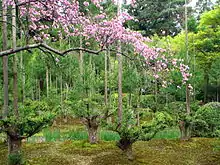Daisugi
Daisugi (台杉) is a Japanese technique similar to coppicing, used on Cryptomeria (Sugi) trees. The term roughly translates to "platform cedar".[1]

Shoots from the base of the tree are pruned so that the trunk stays straight.[2] It is believed that the production of logs by daisugi began in the Muromachi period. At that time, the tea ceremony became popular in part because daisugi logs were used in tea room construction, for example for the tokonoma alcove. The Kitayama area of Kyoto became especially known for its forestry of daisugi.[3][4]
This technique results in a harvest of straight logs without having to cut down the entire tree.[2] Although originally a forestry management technique, daisugi has also found its way into Japanese gardens.[5]
References
- "A Japanese Forestry Technique Prunes Upper Branches to Create a Tree Platform for More Sustainable Harvests". October 27, 2020.
- "Daisugi, the 600-Year-Old Japanese Technique of Growing Trees Out of Other Trees, Creating Perfectly Straight Lumber | Open Culture".
- "Apparently, This Ancient Japanese Technique From The 14th Century Allows People To Produce Lumber Without Having To Cut Down Trees".
- "Daisugi, The Ancient Bonsai Technique That Can Prevent Deforestation". July 10, 2020.
- "Daisugi: The Japanese Forestry Technique of Creating a Tree Platform for Other Trees". October 20, 2020.
External links
![]()